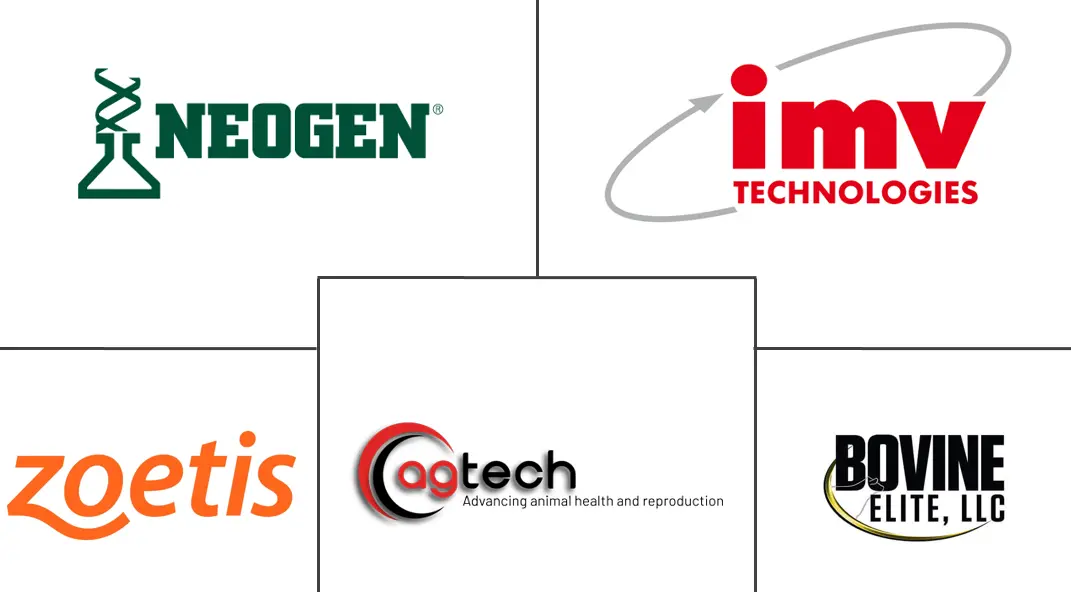Global Veterinary Artificial Insemination Market Size and Share
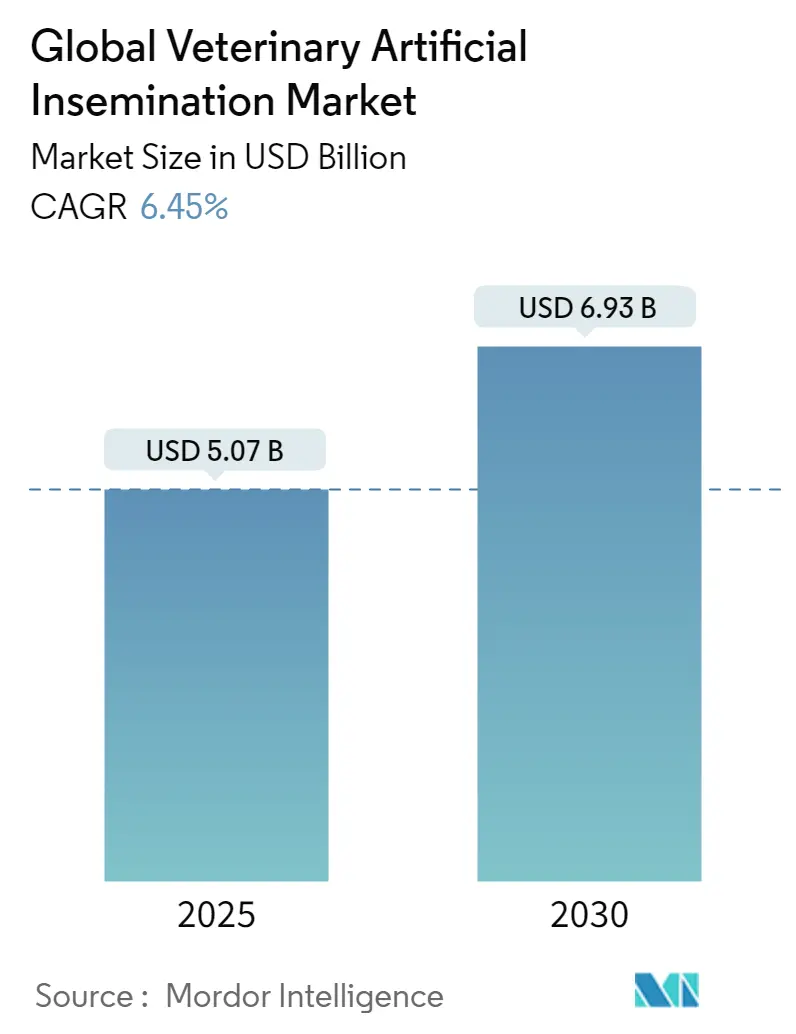
Global Veterinary Artificial Insemination Market Analysis by Mordor Intelligence
The Global Veterinary Artificial Insemination Market size is estimated at USD 5.07 billion in 2025, and is expected to reach USD 6.93 billion by 2030, at a CAGR of 6.45% during the forecast period (2025-2030).
The COVID-19 pandemic has created a significant adverse impact on different sectors, including the Veterinary sectors in several countries. It has caused disruptions in the Livestock Breeding Industry and poultry value chains, leading to a fall in the procurement and sale of animal-sourced food. Animals suffered due to a lack of adequate feed and Veterinary Fertility Services, such as the need for timely artificial insemination, timely pregnancy check, and de-worming. To safeguard farmers and employees against COVID-19, the Animal Husbandry Department of India launched a program in June 2020, which offered telephonic assistance to poultry farmers and owners. Additionally, Veterinary Breeding Services, including artificial insemination, were delivered to farmers at their doorstep during the COVID-19 pandemic. Therefore, such initiatives have contributed to market growth.
The factors driving the market growth include the growing animal and fishery industry and the increasing burden of sexually transmitted diseases. As per an article titled 'Controlling Sexually Transmitted Diseases in Cattle' published in March 2022, sexually transmitted diseases (STDs), such as vibriosis and bovine trichomoniasis (trich), can become a major problem and result in substantial production losses. Hence, protecting farm animals from the spread of sexually transmitted diseases is expected to drive the market. Furthermore, globally, the demand for superior breeds of animals is increasing, which, in turn, is boosting the Animal Genetics Market and increasing the demand for artificial insemination procedures in animals. Additionally, globally, the rising human population and associated advantages, such as decreased cost of housing, increased efficiency of bull usage, safety for farmers and animals, genetic selection, and handling of bulls, are anticipated to drive market growth in the future, thereby boosting the adoption of Animal Breeding Technology.
The artificial insemination technique helps reduce many of the transmitted diseases among Veterinary animals. It allows greater efficiency in terms of genetics and crossbreeding of animals, exemplifying advancements in Animal Reproductive Biotechnology. As per an article titled 'Success Rate of Artificial Insemination, Reproductive Performance and Economic Impact of the Failure of First Service Insemination: A Retrospective Study' published in June 2022, artificial insemination (AI) is recognized as the best technique for increasing reproductive capacity and has received a widespread application in farm animals in Ethiopia. The success of AI is also influenced by endometrial thickness, artificial insemination timing, insemination frequency, and ovarian stimulation protocols. This is expected to increase the demand for artificial insemination (AI) and drive market growth in the forecast period.
Furthermore, as per the Food and Agriculture Organization of the United Nations, October 2021, approximately 50% of the world's population consumes fish as food, which is driving the need for larger production of animals. Therefore, this is expected to boost the demand for Veterinary Artificial Insemination and Animal Reproduction Technology.
However, the high cost of equipment and procedures is expected to restrain the market growth during the forecast period.
Global Veterinary Artificial Insemination Market Trends and Insights
The Veterinary Hospital Segment is Expected to Gain a Significant Market Share in the Veterinary Artificial Insemination Market
The Veterinary Hospital segment is expected to witness significant growth in the market, owing to the rising livestock population, higher prevalence of transmitting diseases, and increasing artificial insemination techniques. In India, the Animal Husbandry Department launched a program to safeguard its employees and farmers against COVID-19. The Veterinary hospitals provided artificial insemination services during the COVID-19 pandemic with preventive measures, such as gloves, masks, sanitizers, and floor cleaners, to maintain the optimal level of hygiene. In the United States, ABC Veterinary Hospital provided artificial insemination services by keeping staff and pet parents safe during the COVID-19 outbreak and implemented new procedures to prevent COVID-19 infection.
Globally, an increasing number of hospitals performing artificial insemination techniques and a rising number of veterinarians are driving the Animal Artificial Insemination Market growth. For instance, as per the Animal Husbandry, Dairying and Fisheries Department 2020-2021 report, in India, field institutions of the department provided breeding services to the cattle population. Furthermore, an artificial insemination service was provided for cattle and buffaloes at the cost of INR 10 per insemination. A total of 48.88 lakh artificial inseminations were performed during the 2019-2020 period.
Furthermore, animals that are in close contact or share the same environment within the Livestock Breeding Industry may result in the spreading of infectious diseases. For instance, in 2019, South Korea discovered its first outbreak of deadly African swine fever (ASF) at a pig farm in Paju, Gyeonggi Province, South Korea. Thus, livestock diseases are also contributing to a set of problems within livestock production systems. These problems include productivity losses, uncertain food security, and loss of income, among others, which are adversely affecting human health. Hence, in order to prevent infectious diseases, the adoption of Animal Breeding Technology, such as artificial insemination, is expected to rise in the coming years.
Therefore, these factors are expected to drive the need for artificial mating and positively influence the Veterinary Artificial Insemination Market.
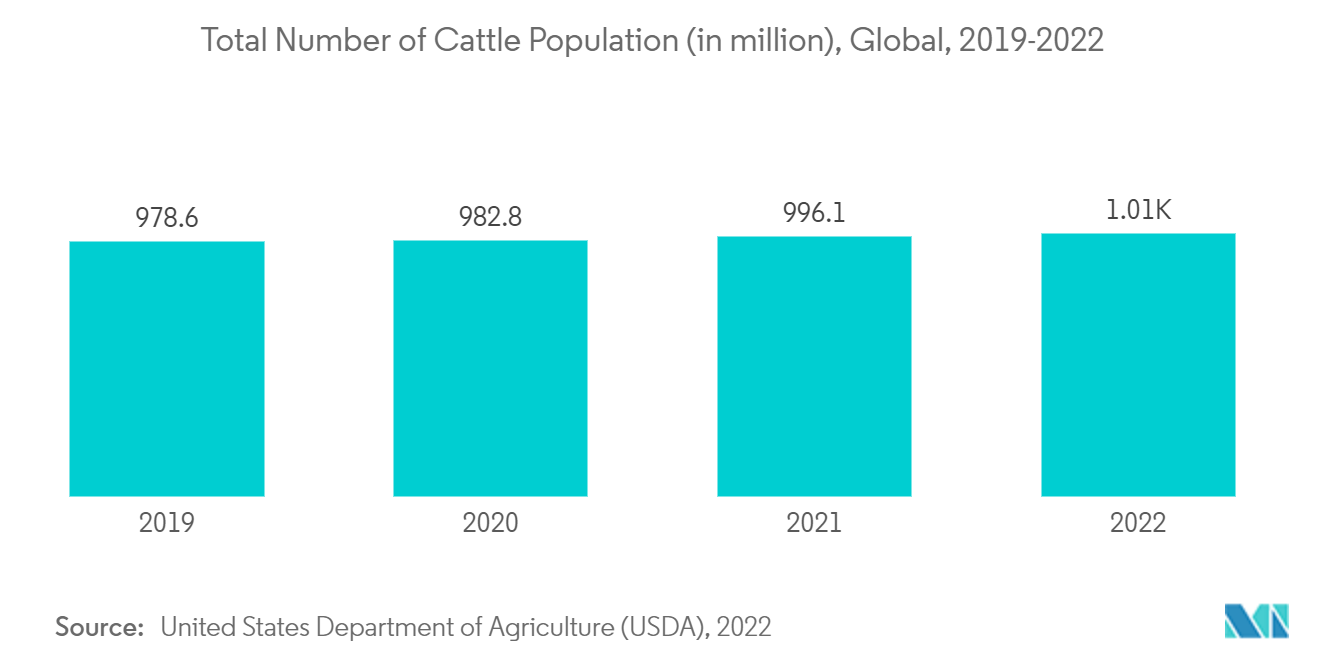
Asia-Pacific is Expected to Witness a Significant Growth in the Market During the Forecast Period
The major factors driving the Veterinary Artificial Insemination Market growth in the Asia-Pacific region include growing infectious diseases in animals and increasing awareness about artificial insemination among people. In Asia, countries like India, China, and South Korea are severely affected due to the COVID-19 outbreak. During the COVID-19 pandemic, in May 2020, in India, the National Dairy Development Board (NDDB) launched an interactive webinar to create awareness about procedures to be followed in the dairy value chain during the COVID-19 pandemic. Additionally, artificial insemination and Livestock Breeding management, difficulties faced by co-operatives, and ensured regular payments to farmers have boosted the market growth.
Avian influenza is a highly contagious viral disease affecting several species of food-producing birds, such as chickens, quails, and pet birds. For instance, as per the World Organisation for Animal Health, key facts data updated in 2021, in Asian countries, avian influenza continues to cause severe losses in poultry. Moreover, there is a rising adoption of Animal Artificial Insemination to reduce the risk of infectious disease transmission among Veterinary animals.
According to a research article by M A Hannan et al., published in the Journal of Veterinary Medical Science in February 2019, embryo transfer in Japan by artificial insemination using frozen semen was found to be useful in improving the productivity of Japanese domestic and special riding horses. As per Animal Husbandry, Dairying and Fisheries Department 2020-2021 report, in India, the department introduced the new technology of sexing the semen by which the sperm responsible for the birth of male calves are sorted and eliminated, and as a consequence, only female calves are produced. Additionally, the government has proposed to adopt new technology by using 2,000 numbers of such semen doses, which may be used for artificial insemination in the farmer's animals on a pilot basis. For instance, in August 2019, Obstetrics of Madras Veterinary College and the Department of Veterinary Gynecology started Cattle Artificial Insemination using sexed semen. These initiatives are expected to support the growth of the Bovine Artificial Insemination Market in the region.
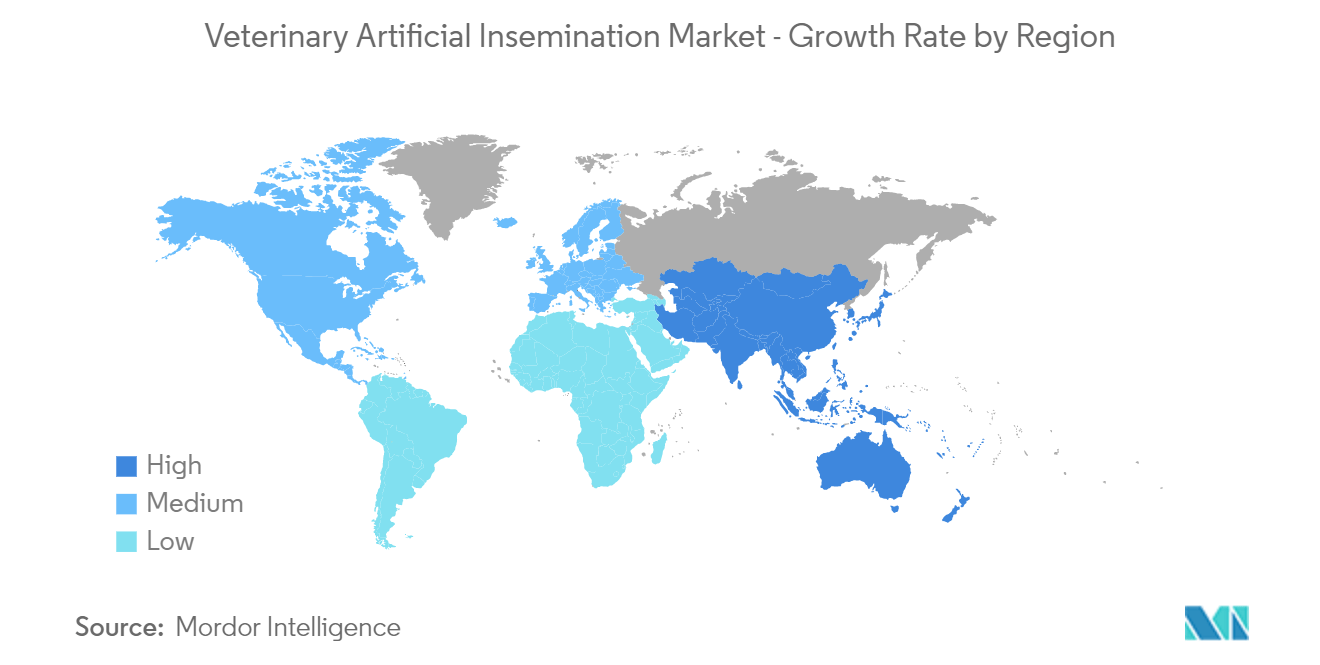
Competitive Landscape
The Veterinary Artificial Insemination Market is moderately competitive, with the presence of both international and local companies holding significant Artificial Insemination Market Share. Some of the companies in the Artificial Insemination Instrument Market are IMV Technologies, Neogen Corporation, Bovine Elite LLC, Agtech Inc., and Zoetis Inc., among others.
Global Veterinary Artificial Insemination Industry Leaders
-
IMV Technologies
-
Neogen Corporation
-
Bovine ELite LLC
-
Agtech Inc.
-
Zoetis Inc.
- *Disclaimer: Major Players sorted in no particular order
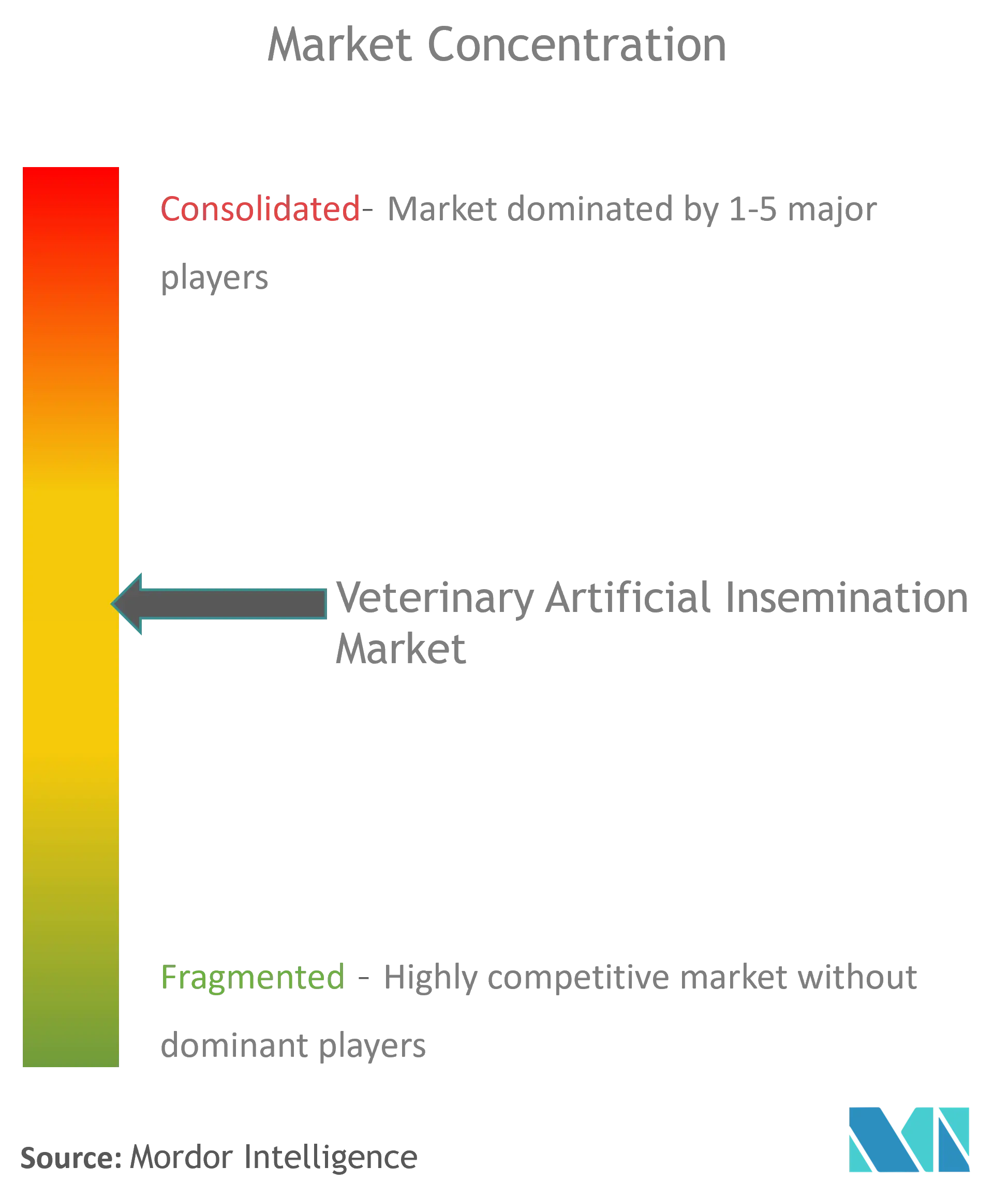
Recent Industry Developments
- In April 2022, Over 400 mobile veterinary units have been approved by the central government for the over 4.6 crore livestock of Madhya Pradesh, India. Each vehicle will have a veterinarian, a paravet, and a vehicle driver-cum-assistant. It will have equipment related to veterinary, minor surgery, and artificial insemination among other facilities
- In August 2020, Cogent collaborated with AB Europe, a sheep breeding company, to launch a novel sexed semen service for sheep producers in the United Kingdom.
Global Veterinary Artificial Insemination Market Report Scope
As per the scope of the report, artificial insemination is a technique of breeding animals through frozen straws with the help of various equipment and reagents. The veterinary artificial insemination market is segmented by product type (equipment, reagents and kits, and other product types), end user (veterinary hospitals, veterinary clinics, and other end users), and geography (North America, Europe, Asia Pacific, Middle East and Africa, and South America). The report offers the value (in USD million) for the above segments.
| Equipment |
| Reagents and Kits |
| Other Product Types |
| Veterinary Hospitals |
| Veterinary Clinics |
| Other End Users |
| North America | United States |
| Canada | |
| Mexico | |
| Europe | Germany |
| United Kingdom | |
| France | |
| Italy | |
| Spain | |
| Rest of Europe | |
| Asia Pacific | China |
| Japan | |
| India | |
| Australia | |
| South Korea | |
| Rest of Asia Pacific | |
| Middle-East and Africa | GCC |
| South Africa | |
| Rest of Middle-East and Africa | |
| South America | Brazil |
| Argentina | |
| Rest of South America |
| By Product Type | Equipment | |
| Reagents and Kits | ||
| Other Product Types | ||
| By End User | Veterinary Hospitals | |
| Veterinary Clinics | ||
| Other End Users | ||
| By Geography | North America | United States |
| Canada | ||
| Mexico | ||
| Europe | Germany | |
| United Kingdom | ||
| France | ||
| Italy | ||
| Spain | ||
| Rest of Europe | ||
| Asia Pacific | China | |
| Japan | ||
| India | ||
| Australia | ||
| South Korea | ||
| Rest of Asia Pacific | ||
| Middle-East and Africa | GCC | |
| South Africa | ||
| Rest of Middle-East and Africa | ||
| South America | Brazil | |
| Argentina | ||
| Rest of South America | ||
Key Questions Answered in the Report
How big is the Global Veterinary Artificial Insemination Market?
The Global Veterinary Artificial Insemination Market size is expected to reach USD 5.07 billion in 2025 and grow at a CAGR of 6.45% to reach USD 6.93 billion by 2030.
What is the current Global Veterinary Artificial Insemination Market size?
In 2025, the Global Veterinary Artificial Insemination Market size is expected to reach USD 5.07 billion.
Who are the key players in Global Veterinary Artificial Insemination Market?
IMV Technologies, Neogen Corporation, Bovine ELite LLC, Agtech Inc. and Zoetis Inc. are the major companies operating in the Global Veterinary Artificial Insemination Market.
Which is the fastest growing region in Global Veterinary Artificial Insemination Market?
Asia Pacific is estimated to grow at the highest CAGR over the forecast period (2025-2030).
Which region has the biggest share in Global Veterinary Artificial Insemination Market?
In 2025, the North America accounts for the largest market share in Global Veterinary Artificial Insemination Market.
What years does this Global Veterinary Artificial Insemination Market cover, and what was the market size in 2024?
In 2024, the Global Veterinary Artificial Insemination Market size was estimated at USD 4.74 billion. The report covers the Global Veterinary Artificial Insemination Market historical market size for years: 2019, 2020, 2021, 2022, 2023 and 2024. The report also forecasts the Global Veterinary Artificial Insemination Market size for years: 2025, 2026, 2027, 2028, 2029 and 2030.
Page last updated on:
Global Veterinary Artificial Insemination Market Report
The Veterinary Artificial Insemination Market is segmented by product type and end user, offering a comprehensive industry analysis. The product types include equipment, reagents and kits, and other product types, while the end users are segmented into veterinary hospitals, veterinary clinics, and other end users. The report provides an industry overview, highlighting the market trends and market growth within the veterinary artificial insemination sector.
The market forecast offers insights into the future direction of the market, supported by industry research and market data. This market report includes a detailed market review and market segmentation, providing valuable industry information for stakeholders. The report also includes a market outlook, discussing the market predictions and industry outlook for the coming years.
In addition to the market analysis, the report provides a historical overview of the market, giving context to the current market value and market size. The industry reports and industry statistics included in the report offer a comprehensive view of the market, while the industry trends and market leaders are analyzed to give a clear picture of the competitive landscape.
The report includes a free report PDF download, which serves as a report example for those interested in the market. Research companies will find the industry sales data and market growth rate particularly useful for their analyses. The market forecast and market overview sections provide a detailed look at the expected developments in the veterinary artificial insemination market.
Overall, this report serves as a valuable resource for understanding the veterinary artificial insemination market, offering insights into market value, market segmentation, and industry size. The report example provided in the form of a report PDF can be a useful tool for further research and analysis.
